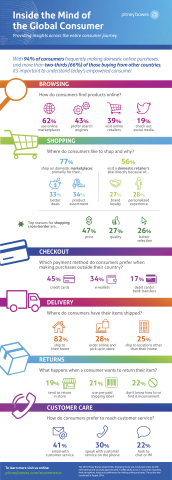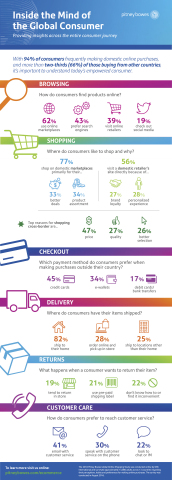STAMFORD, Conn.--(BUSINESS WIRE)--Pitney Bowes (NYSE:PBI), a global technology leader providing innovative products and solutions powering anywhere-to-everywhere commerce, today announced the results of the third annual Pitney Bowes Global Online Shopping Survey, which finds that cross-border ecommerce has become prevalent among consumers around the world. It’s no surprise that consumers frequently make domestic online purchases (94%), however more than two-thirds (66%) of consumers that have ever made a domestic online purchase have also made an online purchase from another country in the past year. Singapore (89%), Australia (86%) and Hong Kong (85%) have the highest number of cross-border shoppers, while countries like Japan (34%) and the U.S. (45%) are still growing in cross-border confidence.
The World Shops
The survey findings suggest that online shopping has become a way of life for many shoppers. Nearly one-third of these consumers now say they make domestic online purchases on a daily or weekly basis, with over two-thirds in China reporting this regularity. As domestic online shopping becomes more frequent, it can create familiarity and comfort to reach across borders. Not surprisingly, cross-border shopping occurs less frequently than domestic shopping with the majority of consumers (58%) shopping monthly or annually. Top countries for monthly/annual cross-border shopping include Australia (78%), Singapore (77%), Canada (72%), Mexico (71%) and Hong Kong (70%).
What also drives cross-border shopping is the mutually-beneficial union between physical stores and online shopping, which could provide a huge opportunity for retailers and brands. Survey findings uncovered that 63 percent of consumers that have shopped cross-border are now participating in what Pitney Bowes is describing as “In-store Global. Online Local.” This phenomenon is when consumers make in-store purchases during their international travels, and follow up with online purchases from that same cross-border retailer. Most cross-border shoppers in South Korea, China and India cited that they often or always revisit a retailer online following international travels.
Shopping Here, There and Everywhere
Today’s consumers have the power of choice, whether choosing to shop online direct to a retailer website or an online marketplace, and the study shows that consumers like it that way. In fact, while consumers may have a preference for one channel over the other, very few shop exclusively through one online channel.
Approximately half of consumers say that all or most of their online shopping, whether domestic or cross-border, is through an online marketplace. The top countries in which shoppers choose all or most of their cross-border marketplace purchases are Japan (70%), China (61%), Germany (59%) and India (55%). About a quarter of global shoppers choose the retailer’s direct site for all or most of their cross-border shopping. The top direct-to-retail countries are Canada (35%), South Korea (34%) and Australia (33%). The remaining shoppers shop both marketplaces and retailers with no leading preference. This suggests that retailers should consider a broad presence and multiple channels to reach global shoppers.
“Consumers across the world have spoken. We have moved beyond the days of marketplace or retailer; in-store or online; or even in-country or cross-border,” says Lila Snyder, President, Global Ecommerce, Pitney Bowes. “The world is shopping—everywhere—as new consumer behaviors and trends have emerged. Entering the holiday season and a new year, retailers and marketplaces alike should take note and capitalize on these shifts in consumer behavior, which open up new opportunities for brands and retailers at home and abroad.”
Shopping in the Mobile Age
Throughout the shopping journey, mobile devices are playing an increasingly greater role. Roughly half of shoppers in Singapore (51%), India (50%), Mexico (49%) and China (47%) were most likely to use a mobile device (including tablets and phones) for browsing. When it comes to order tracking, over half of shoppers in China, Hong Kong, India, Singapore and South Korea use these devices. Even though mobile is not the first choice for completing a purchase (33%), surveyed shoppers often use their mobile device for part of the shopping journey. For example, in the U.S. one-third of shoppers (33%) use mobile for completing a purchase, however mobile usage increases significantly (47%) when tracking an item post purchase. The data reveals a strong tracking application as highly strategic to reaching the mobile shopper.
Survey results uncovered insight into how consumers are finding products online. While marketplaces (62%), search engines (43%) and retailers’ sites (39%) continue to be popular discovery tools, countries like Hong Kong (26%), Australia (24%) and Singapore (22%) rely on email communications to find new products. And now nearly one-fifth (19%) of consumers are discovering new products through social media channels, especially in Hong Kong (45%), Mexico (32%), India and Singapore (both 30%). In fact, Hong Kong consumers are just as likely to use social channels to discover new products as they are a retailer’s website, while consumers in Mexico are more likely to use social media than visit a retailer’s website.
Getting the Basics Right Still Matters
The need for choice was also evident with regard to payment types. While survey results varied by country, no one payment option was chosen by a majority of cross-border shoppers. Credit cards (45%) were the most preferred method of payment online. E-wallets, which allow consumers to store multiple payment accounts in one place (i.e. PayPal, Alipay), were identified as another popular payment method (34%) for cross-border purchases. Choice again proved to be a crucial theme, as limiting options for payment alienates a significant number of would-be consumers. When asked about the most important factors in selecting a payment option, consumers cited service fees/total cost of purchase (33%), value of the purchase (25%), and offer of a purchase protection plan (25%) as the most important considerations when selecting a payment option.
Online shipping and returns continue to be a major pain point for consumers, despite merchants’ efforts to improve their shipping and returns processes. When asked about holiday shopping, 42 percent of consumers say they experienced related challenges when shopping online for the 2015 holiday season. In fact, even the most basic elements of the customer experience, such as shipping the right item; accuracy in address and tracking; a transparent returns policy; and proper duty and tax were all cited as challenges. Hong Kong (65%), India (59%), South Korea (55%), Singapore and China (both 54%) were among the countries experiencing the greatest headaches with online shopping during the 2015 holiday season. Even in the U.S., almost a third of consumers (31%) reported experiencing challenges during last year’s holiday shopping season, putting the pressure on retailers and marketplaces to make significant improvements in the consumer experience heading into this holiday.
Methodology
The 2016 Pitney Bowes Global Online Shopping Study was conducted online by ORC International and surveyed approximately 13,000 adults across 13 countries regarding their perceptions, habits and preferences for making online purchases. This year’s survey polled Singapore, Hong Kong and Mexico for the first time, where they joined survey participants from Australia, Canada, China, France, Germany, India, Japan, South Korea, the United Kingdom, and the United States. The survey was conducted in August 2016.
About Pitney Bowes
Pitney Bowes (NYSE: PBI), is a global technology company powering billions of transactions – physical and digital – in the connected and borderless world of commerce. Clients around the world, including 90 percent of the Fortune 500, rely on products, solutions and services from Pitney Bowes in the areas of customer information management, location intelligence, customer engagement, shipping, mailing, and global ecommerce. And with the innovative Pitney Bowes Commerce Cloud, clients can access the broad range of Pitney Bowes solutions, analytics, and APIs to drive commerce. For additional information visit Pitney Bowes, the Craftsmen of Commerce, at www.pitneybowes.com.
# # #




